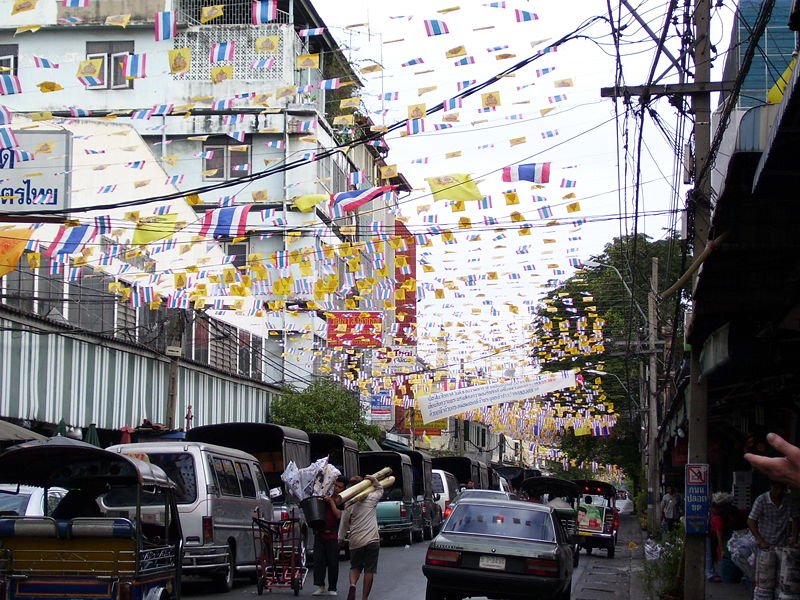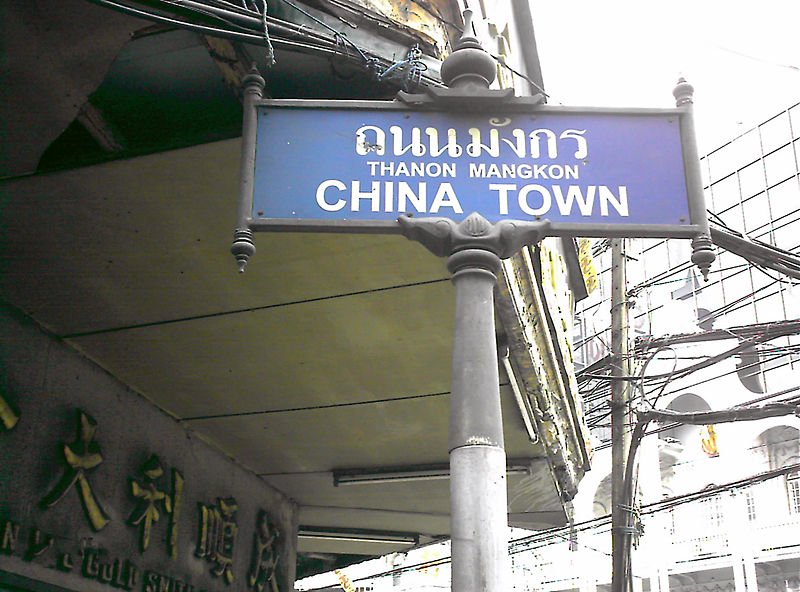 Sampheng, also called Samphanthawong district, is the Chinatown of Bangkok. It was here that the Chinese merchants and traders settled after their original settlement at Phra Nakhon district at the bend of the Chao Phraya River was taken over by King Rama I, to create the Rattanakosin district in which the king constructed the Grand Palace. Today, two hundred years after they settled at Samphanthawong, Chinatown continues to have a distinctly Chinese feel to it.
Sampheng, also called Samphanthawong district, is the Chinatown of Bangkok. It was here that the Chinese merchants and traders settled after their original settlement at Phra Nakhon district at the bend of the Chao Phraya River was taken over by King Rama I, to create the Rattanakosin district in which the king constructed the Grand Palace. Today, two hundred years after they settled at Samphanthawong, Chinatown continues to have a distinctly Chinese feel to it.
Scene in Chinatown, Bangkok (29 August 2006)

When the Chinese arrived in Samphanthawong, there were few roads. One of them was Sampheng Road, which today is known as Wanit I Road. It was the main road in Sampheng until the construction of Yaowarat Road in 1892.
For a Chinatown experience, walk along Thanon Yaowarat and Soi Issaranuphap. Within the Chinatown of Bangkok, like many other Chinatowns in other cities of the world, one can find medicine shops, gold merchants and sidewalk stalls punctuated by the occasional Chinese temple. At the east end of Chinatown, near the Thien Fah Foundation, is a Chinese Gate erected to commemorate King Bhumibol's 72nd birthday. It is often called Odean Gate, after the Odean theatre that used to stand nearby. The Hualamphong Railway Station forms the east end of Chinatown while the Indian community of Pahurat is immediately to the west.
 Street in the Bangkok Chinatown
Street in the Bangkok Chinatown https://commons.wikimedia.org/wiki/File:Bangkok_China_Town.jpg
https://commons.wikimedia.org/wiki/File:Bangkok_China_Town.jpg Bartlebooth
Bartlebooth
Charoen Krung Road
Charoen Krung Road is one of the major roads in Chinatown. It is also the first paved road in Bangkok. Charoen Krung Road was built in 1861 by King Rama V (King Mongkut). Although it is the oldest road in Bangkok, it's name "Charoen Krung" actually means "new" road. It starts at the Sanam Chai roundabout at Rattanakosin, near the Temple of the Reclining Buddha, and makes a curve southwards, passing through Pahurat and Chinatown for a distance of over 8 kilometers. At the Mit Phan Road junction, Charoen Krung Road ends and Rama VI Road begins.Yaowarat Road
Yaowarat Road is today regarded as the high street of Chinatown. Until it was built in 1892, the main road in Chinatown was Sampheng Road, which today is called Soi Wanit 1 (Wanit 1 Lane). Yaowarat Road extends for about 1.5 kilometers, and both sides are bustling with shops selling a variety of Chinese merchadise. Signboard for Mangkon Road in Chinatown, Bangkok
Signboard for Mangkon Road in Chinatown, Bangkok https://commons.wikimedia.org/wiki/File:Mangkon03.JPG
https://commons.wikimedia.org/wiki/File:Mangkon03.JPG hkgalbert
hkgalbert
Chinatown Gate
Chinatown Gate is an archway, often called Odean Gate, which was erected to commemorate the 72th birthday of King Bhumibol Adulyadej.Getting there
Take the MRT to Hualamphong Railway Station, which is the western gateway into Chinatown. You can also go there by boat, alighting at the Ratchawong Cross Ferry Pier and then walking Ratchawong Road that takes you to the centre of Chinatown.Nearby Sights
- Chinatown Gate
- Wat Traimit: Temple famous for the biggest solid-gold Buddha statue in the world
- Wat Pathum Khongkha: This is an ancient Buddhist temple which was originally known as Wat Sampheng
- Wat Chakkrawat
- Leng Buai Ia Shrine: oldest Chinese shrine in the area, over 300 years old
- Ah Nia Geng Shrine: shrine to the Kuan Yin
- Guan U shrine
- Thian Fah Hospital: Hospital established by the Chinese to provide health care for the poor.
- Bunyasamakhom Shrine

 Go Back
Go Back